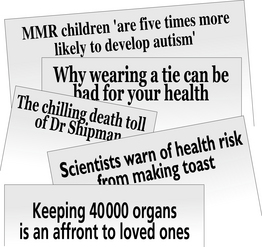Chapter 26 Media and health
The role of the media
The mass media are a rich source of information about all aspects of health. They are constantly presenting us with ideas about everything from the symptoms of disease or the risks of different behaviours to the validity of government health policy or the trustworthiness of the medical profession (Fig. 1). That is why so much money is now spent on trying to affect media representations, through advertising, public relations activities, media advocacy and direct health education initiatives. However, the role of the media is not straightforward. A direct impact may be evident when, for example, doctors are flooded with enquiries after a particular health ‘scare’. However, such responses are often very short-term. People are certainly not naive and unreflective media consumers, ready to absorb any message indiscriminately. If they were, then campaigns to encourage us to stop smoking or eat less fat would be more successful! On the other hand it is true that certain controversies, such as when questions were raised over the safety of the measles, mumps and rubella (MMR) vaccine, have had tangible effects. Even in this case, however, while vaccination declined by 10% the ‘scare’ did not have as big an impact as might have been expected. ‘Most parents trusted health professionals, friends and family more than the media and continued to accept the MMR vaccine’ (Boyce, 2007: 188).
Research into how people actually respond to the media tends to show that they act as sophisticated audiences, choosing how to engage with media facts, images, stories, characters and plots in relation to their own lives (Boyce, 2007; Henderson, 2007). In addition, each media ‘message’ competes with ideas and information from other media and broader cultural sources. How we respond also depends on social and economic context, the ease with which we can change our behaviour and the ways in which any particular media representation relates to our self-image, aspirations, group identity and networks. Sometimes the same media representations can even generate diametrically opposed responses from different social groups. For example, the British soap opera Brookside included a storyline about a businesswoman, Susannah, successfully standing up to a man who complained about her breast-feeding in a café-bar. This storyline was welcomed by middle-class breast-feeding women, who felt inspired by it. Reactions were strikingly different among a group of young working-class women. Susannah’s strength of will did not fit with these women’s self-perceptions: ‘You need to be confident, which I’m not’. Clearly, if breast-feeding in a café-bar might cause a scene and necessitate a robust defence then trying to do it in the local burger joint would be likely to be even more controversial. For these women the Brookside episode seemed to reinforce the fact that breast-feeding in public was ill advised, rather than encourage them to think of it as an option (Henderson et al., 2000; see Case study).
Stay updated, free articles. Join our Telegram channel

Full access? Get Clinical Tree



